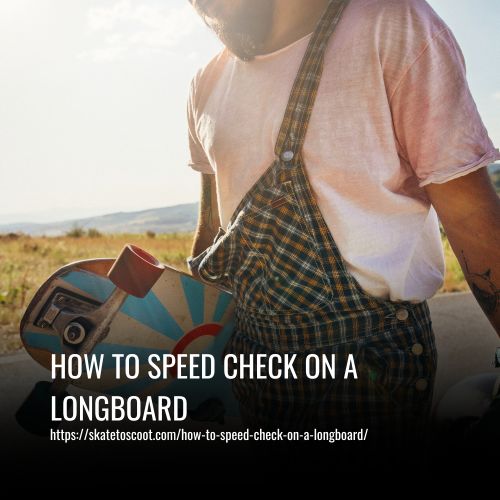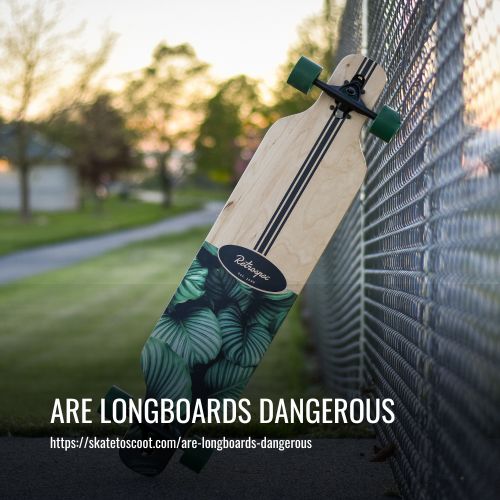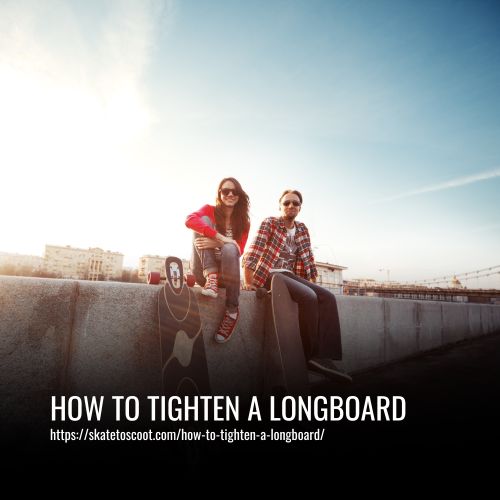As an Amazon Associate we earn from qualifying purchases.
Are you ready to take your longboarding skills to the next level? If you’ve mastered the basics and want to push the limits of speed, then you’re in the right place. Speed checking on a longboard is a crucial skill that every advanced rider should have in their arsenal.
But what exactly is speed checking? It’s a technique used to control your speed and maintain stability while going downhill on a longboard. By using specific maneuvers and techniques, you can safely navigate steep slopes and avoid any potential accidents or wipeouts.
In this article, I’ll walk you through the step-by-step process of how to speed check on a longboard, ensuring that you can confidently tackle those high-speed descents with ease. So buckle up, because we’re about to dive into the exciting world of speed checking on a longboard.

How to Speed Check on A Longboard: Step-by-Step Guide
Speed checking on a longboard requires specific maneuvers and techniques to maintain control and stability while going downhill. Here’s a step-by-step guide for how to speed check on a longboard:
1. Set up For the Speed Check
Before you start your speed check, make sure you are in a safe place to do so. Ensure there is plenty of space in front of and behind you and no obstacles in your way. Be mindful of any other people or traffic around you.
2. Get into a Position to Start
To prepare for your speed check, get into a comfortable starting position. This usually means leaning slightly forward with your weight evenly distributed between your front and back wheels. If you’re new to longboarding, placing your dominant foot in the front can give you more control and stability when picking up speed. Make sure your bearings are well-lubricated and your deck is clean and free of debris.
3. Push Off and Get Going
Push off from the ground to gain momentum. Place your dominant foot slightly in front of the back wheel and the other foot behind the back wheel, heel resting on the board. Use your dominant foot to push off the ground and use your other foot to assist with momentum. Continue pushing until you’ve reached your desired speed.
4. Start Checking Your Speed
Once you’re up to speed, start checking your speed using the techniques we discussed earlier. Find an open space where you can safely accelerate to full speed. Take a few practice runs and pay attention to how fast you’re going. Regularly use the speed check techniques as you approach your maximum speed to stay in control and avoid accidents.
5. Stay in Control and Don’t Wipe Out
To stay in control and avoid wiping out, keep your center of gravity low by keeping your weight towards the middle of the board. Use your arms and shoulders to help steer and maintain control. If you start to lose control, relax and let the board slow down on its own. Avoid fighting it. If you do wipe out, try to relax and roll with the fall to minimize damage.
6. Practice, Practice, Practice
The key to becoming proficient at speed checking on a longboard is to practice regularly. Find a safe space where you can safely accelerate and practice speed checks. The more you practice, the easier it will become. Remember to always practice in a safe and controlled environment.
7. Bring Your Board Back Into the Initial Stance
After determining your speed, bring your longboard back into the initial stance. Slowly shift your weight back to the front of your board until you are in the starting position. Keep your knees slightly bent and your weight on your front foot, ready to take off again.
Why It’s Important to Check on A Longboard?
It is crucial to regularly check your speed while longboarding for several reasons. Firstly, maintaining control over your board is vital, and excessive speed can compromise your ability to do so. At high speeds, your center of gravity becomes elevated, making it challenging to maintain balance and stability. This can lead to speed wobbles, a dangerous phenomenon where the board begins to shake uncontrollably.
Moreover, riding at excessive speeds increases the risk of accidents. Without effective speed checks, you may not be able to stop or slow down in time, putting yourself, others, and property in danger. By being aware of and controlling your speed, you can prevent potential collisions and maintain a safe distance from obstacles.
Lastly, precise speed management enables you to execute turns smoothly and effectively. Riding too fast limits your control and may prevent you from maneuvering accurately, ultimately hindering your progress toward your intended destination.
Things You’ll Need
Things You’ll Need to Speed Check on a Longboard:
- Longboard: You’ll need a longboard to perform a speed check. Choose a longboard that suits your riding style and preferences.
- Helmet: Safety should always be a top priority. Wear a helmet to protect your head in case of a fall or collision.
- Pads: To further protect yourself, wear pads on your elbows and knees. This will help cushion any impact and reduce the risk of injuries.
- Space to Ride: Find a wide and open area where you can ride your longboard safely. Look for a smooth surface free of obstacles or rough patches.
- Target Object: Select a target object to practice your speed checks. This can be a cone, rock, or any other object that you can safely aim for and avoid.
When you have all these materials ready, you can start practicing your speed checks. Remember to always prioritize safety, control your speed, and maintain a safe distance from obstacles. By mastering the technique of speed checking, you’ll be able to ride confidently and enjoy your longboarding experience to the fullest.
Essential Tips and Tricks for Doing a Speed Check on Your Longboard
Performing a speed check on your longboard is a crucial technique to help you maintain control and avoid accidents when riding at high speeds. Here are some essential tips and tricks to keep in mind when executing a speed check slide:
- Keep your knees bent: It is important to always keep your knees bent throughout the speed check. This helps you maintain balance and control on the board.
- Carve into the slide: Before initiating the speed check, carve into it by bending your knees lower and “compressing” into the longboard. This will create more stability and ease when kicking out with your back foot.
- Rotate your shoulders and hips: As you carve into the slide, rotate your shoulders and hips as much as possible while leaning back. This will add to your stability and make it easier to maintain control during the speed check.
- Maintain a slight angle: Aim to keep the board at a slight angle during the speed check, with the wheels still spinning. To help achieve this, position your front foot at a 45-degree angle with your deck instead of 90 degrees.
- Deweight your back trucks: Right before pulling the longboard back in and completing the speed check, deweight your back trucks again. This will make it easier for them to slide back into position.
- Extend your front arm: Extend your front arm towards the downhill direction to avoid going into a 180-degree slide. This will help you maintain the proper stance and control during the speed check.
- Lean back and hold the slide: Lean back to hold the speed check slide for as long as necessary. This will give you more time to assess your speed and maintain control.
- Bring your arm, shoulders, and hip back into the initial position: When you’re ready to hook up and resume your ride, bring your arm, shoulders, and hip back into the initial position. This will allow for a smooth transition and help you maintain stability.
By following these essential tips and tricks, you can confidently execute a speed check on your longboard, ensuring a safe and controlled ride at high speeds. Remember to practice regularly and gradually increase your speed as you become more comfortable with the technique.
Proper Practice Makes More Perfect
Proper practice plays a crucial role in mastering the skill of speed-checking on a longboard. Whether you’re a beginner or an experienced rider, dedicating time to practice will help you improve your technique and ensure a smoother, safer ride. Here are some important tips for proper practice:
- Find a suitable practice area: Look for a spacious, open area with a smooth surface. This will provide you with ample room to practice your speed checks without any obstacles or distractions.
- Start with the basics: Begin by focusing on the basics of speed checking. This includes mastering the technique of bringing your longboard back to the center and stopping after reaching your top speed. Practice this fundamental skill repeatedly to build muscle memory and improve control.
- Gradually increase speed: As you become more comfortable with the basic speed check, gradually increase your speed. This will help you get accustomed to checking speed at different velocities and develop a better understanding of your board’s capabilities.
- Vary your practice sessions: Don’t limit yourself to practicing in one setting or situation. Experiment with different terrains, such as hills and flat areas, to simulate real-life riding scenarios. This will enhance your adaptability and preparedness for various conditions.
- Incorporate turns and maneuvers: Once you feel confident with straight-line speed checking, start incorporating turns and maneuvers into your practice sessions. This will help you develop the ability to check speed effectively in different situations, ensuring you maintain control and stability during rides.
- Learn from experienced riders: Observing and learning from experienced longboarders can greatly aid your progress. Watch videos, join local longboarding communities, and seek advice from seasoned riders. They can offer valuable insights and tips to refine your technique.
- Practice regularly: Consistency is key. Regularly dedicating time to practice speed checking will lead to noticeable improvements over time. Aim for short, focused practice sessions multiple times per week to reinforce your skills and build confidence.
Remember, perfecting the skill of speed-checking on a longboard takes time and perseverance. By following these tips and investing effort into regular practice, you’ll enhance your abilities and ensure a more enjoyable and safe longboarding experience.
Avoiding the Deadly Speed Wobble on a Longboard
Experiencing a speed wobble while riding your longboard can be a terrifying and dangerous situation. However, with some practice and the right techniques, you can avoid this deadly wobble. Follow these simple steps to stay safe on your longboard:
- Position yourself correctly: Stand with your feet shoulder-width apart and keep your knees slightly bent. This will help you maintain balance and stability as you check your speed.
- Apply gentle pressure to the front of your board: To slow down and navigate curves or obstacles, apply slight pressure to the front of your longboard. Be careful not to apply too much pressure, as this can throw off your balance.
- Keep your body stable: Use your arms and legs to maintain stability. Keep your arms close to your body and tuck your knees close to your chest. This position helps you stay upright and avoid the dreaded speed wobble.
- Practice regularly: Consistency is key. Dedicate regular practice sessions to improving your technique and mastering speed checking. With practice, you will become more confident and proficient at avoiding speed wobbles.
By following these steps and practicing regularly, you can develop the necessary skills to avoid the deadly speed wobble on your longboard. Stay safe and enjoy your ride!
FAQs
Speed checking is a crucial skill when riding a longboard, especially when going downhill at high speeds. One effective method is the foot brake, in which you drag your back foot on the ground to gradually slow down.
Another technique is a slide called a heelside slide or hands-down slide. This involves placing your hands or gloves on the ground while sliding your board sideways, creating resistance and reducing your speed. Depending on your skill level and preferences, you can choose the method that works best for you.
Using gloves while longboarding is highly recommended, especially when performing speed checks and slides. Gloves provide hand protection, improved grip on the pavement, and can help reduce the risk of injuries from falls. Look for gloves specifically designed for longboarding or downhill riding, with features such as durable materials, slide pucks, and double stitching for enhanced durability.
While it is technically possible to ride a longboard without a helmet or safety gear, it is strongly advised against. Longboarding involves risks, especially at higher speeds or when performing tricks and slides. Wearing a helmet is crucial to protect your head from potential falls or collisions. Additionally, it is highly recommended to wear knee pads, elbow pads, and wrist guards to minimize the risk of injuries.
Conclusion:
Mastering the art of speed checking on a longboard is not only a skill but a thrilling experience that will take your riding to new heights. By practicing these techniques and staying focused, you’ll be able to confidently navigate any downhill slope with ease.
So, gear up, hit the pavement, and let the adrenaline rush take over as you become a speed-checking pro on your longboard! Ride safe and enjoy the exhilarating ride!
Amazon and the Amazon logo are trademarks of Amazon.com, Inc, or its affiliates.



